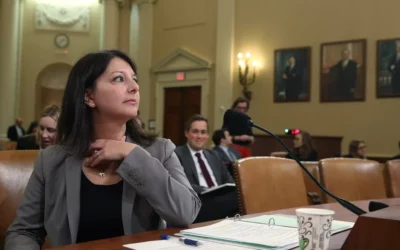![]()
Original article courtesy of the VPM / NPR / PBS.
by ANGIE MILES Writer, Host
Updated Thurs May 2, 2024
TRANSCRIPT OF VIDEO
ANGIE MILES: During the 20th century, millions of Black people left America’s rural South in search of a better life in the North. Over the last 30 years, however, a new migration of people has been occurring as Americans are moving en mass to the South. Our guest, Jeanne Milliken Bonds, is a public policy professor from the University of North Carolina and she’s studied this most recent trend. Thank you so much for joining us.
JEANNE MILLIKEN BONDS (PUBLIC POLICY PROF., UNC KENAN FLAGLER BUSINESS SCHOOL): Thank you, happy to be here.
So, give us a sense of the headline. What is the big story when it comes to Virginia and migration in the last several years?
Well, the South has been attracting population from all over the country as well as internationally for the past five decades. And so, the South has really emerged as the nation’s primary growth magnet driven by those gains from those different population groups. In Virginia, the story is really exactly the same, except that within Virginia you have some counties and independent cities that have gained in population and you have others that continue to lose population.
What is it about Virginia, the South, but Virginia, that’s attracting so many people?
Starting in the seventies, the climate, the jobs, a lot of economic development taking place in the South, less expensive housing, less expensive taxes, all of those were drivers that were bringing people to really rediscover the South and move back into the region. And it was a much more populate, different population group because it was international individuals moving back, people who had left the South previously coming back and then newcomers discovering the South.
What about the notion of becoming browner and grayer as Virginia is sometimes described?
Absolutely. The South, well the country in general, is becoming browner and grayer and that’s no different for the South or Virginia. And that is the native white population, much slower growth because the fertility rate has dropped since about 2008. And you have a population primarily pre-boomer and boomer that’s aging and it is not being replaced. So, you have that native population declining, the white population, and then you have this diversity moving in from other parts of the country as well as international migration into the state. So that has created a much more dynamic and browner population in Virginia, in the South overall.
The southern parts of Virginia have lost population in recent years. Again, do we know reasons for that? Why are people leaving there and moving to other areas?
Well, they’re not necessarily leaving there and moving to other areas, those areas are your more rural parts of Virginia, the ones along the border with North Carolina and the southwestern. Different changes in the economic structure, coal, for example, in the southwestern part. So, you have some changing economic dynamics. And again, you have that white native population that’s aging, plus you have deaths of a lot of the white population from COVID recently, but also opioid deaths in that area. So many of those counties are defined as biologically declining or even biologically dying because more people are leaving. Maybe they’re going off to college or moving to other areas, than are coming in. And more people are dying than are being born. So, you have a dynamic within Virginia as well as other states where you have some counties and cities that are just natural magnets for growth. In Virginia, that’s Northern Virginia, the Tidewater area, Charlottesville and Richmond.
And we also have a strain sometimes on infrastructure. We need roads, we need schools, we need ways to support the people who are moving into an area. And talk a little bit, if you would, about the strain that it can place on those individuals, especially if the tax base is not there to support that infrastructure.
People started moving to the South around 1970 because taxes were less, housing was less expensive. But then suddenly you have this boom taking place where people are moving in, that they come in from other regions of the country, often with higher incomes and we call that a migration dividend. So, they move in from other parts of the country, higher income, more to spend on housing. So, they drive the cost of housing up, they drive the demand for services up and that local economy has to absorb that and add that into the mix. So, for that reason, during the pandemic, not only did you have people leaving some of those high density urban areas just to spread out and acquire more space because we were in a pandemic, but you also had that housing costs really soaring. So, people either moved just outside those magnet counties into what we would call pole counties, P-O-L-E, and they started absorbing some of those individuals, or they left the state in general and moved further south.
If you had to predict, based on what you’ve seen in studying these patterns from 1970 to the present, what would you say the makeup and migration patterns in Virginia, and in the South more broadly, might look like in another 20 or 30 years?
Well, the South continues to attract people. It’s at a much slower pace than it was, and that’s largely because of the pandemic. And then, overall in the country, the population growth has slowed down and that fertility rate has dropped for every demographic group except Pacific Islanders. So overall we see a population decline. So, looking out into the future at Virginia, you’re going to continue to have a white population that’s decreasing just because of age. And unless we turn around the numbers of people dying from opioid addiction as well as effects from COVID, that white population decline is going to continue simply because of age. So really the question remains, will the South, will the U.S., will Virginia still attract international migration and will the South, even given increased housing costs, still attract people from other parts of the country? So that part is a bit unknown as we see how the economy shakes out, continued in this post pandemic era. But one thing is for sure, is that the white population is aging and will continue to decline.
Thank you very much for your insight and for your years of studying these, years of migration patterns. And we appreciate you joining us to talk about it today. It’s Jeanne Milliken Bonds and thanks for being with us on Focal Point.
JEANNE MILLIKEN BONDS: Thank you so much.
 Jeanne Milliken Bonds is a Professor of the Practice, Impact Investment and Sustainable Finance in the Kenan-Flagler Business School and the Department of Public Policy at UNC-Chapel Hill.
Jeanne Milliken Bonds is a Professor of the Practice, Impact Investment and Sustainable Finance in the Kenan-Flagler Business School and the Department of Public Policy at UNC-Chapel Hill.
Other News
The EIDC Economic Development Journal – Fall 2023
WCH In the NewsThe EIDC Economic Development Journal - Fall 2023 International Economic Development Council1275 K Street, NW, Suite 300 • Washington, DC 20005 • www.iedconline.orgChair: Jonas Peterson, CEcDPresident & CEO: Nathan OhleEditor: Jenny Murphy.November...
The painful pandemic lessons Mandy Cohen carries to the CDC
The painful pandemic lessons Mandy Cohen carries to the CDC"North Carolina initially failed to prioritize testing for people who were exposed to #COVID19 because of where they live or work." - Jeanne Milliken Bonds, Professor of Social Impact Investing at the...
Analysis: South’s Population Growth Can Lead to Prosperity if Local Governments Support Entrepreneurs
WCH In the NewsAnalysis: South's Population Growth Can Lead to Prosperity if Local Governments Support Entrepreneurs Original article courtesy of Daily Yonder.by James H. Johnson, Jr., Jeanne Milliken Bonds and Wendell M. Davis November 30, 2022 ...





 Angie Miles
Angie Miles

